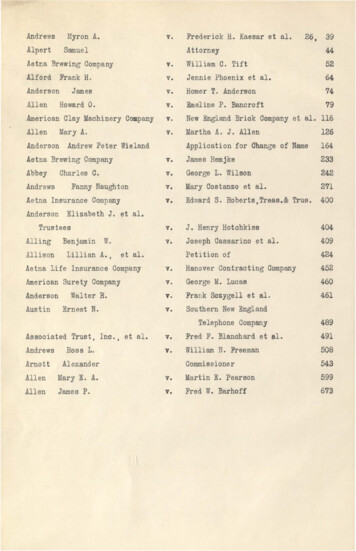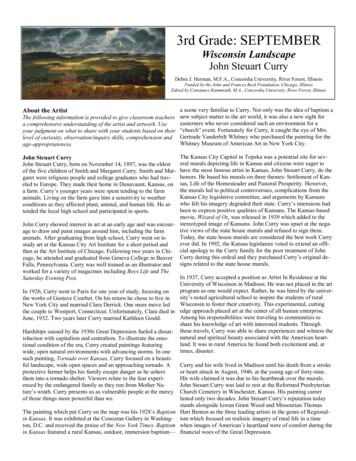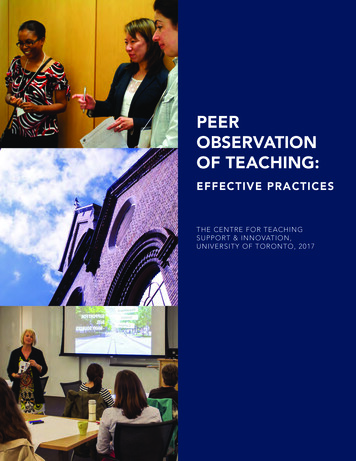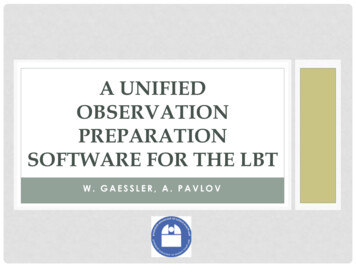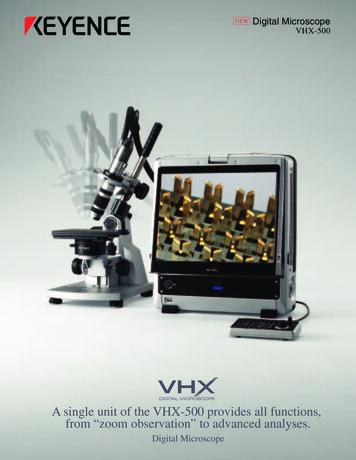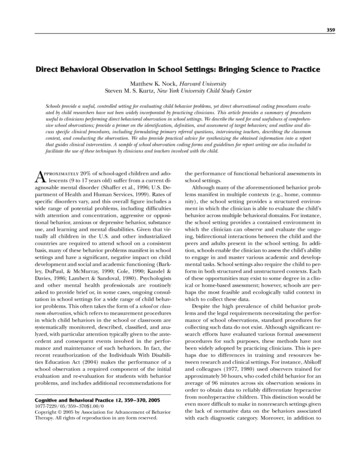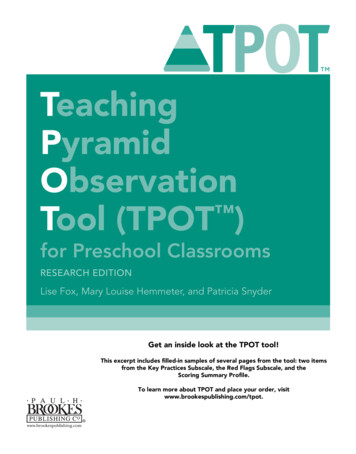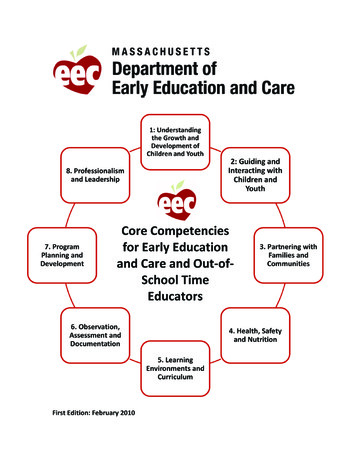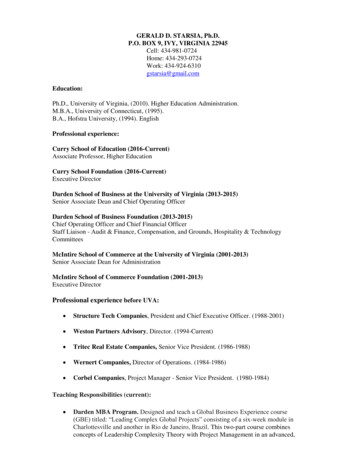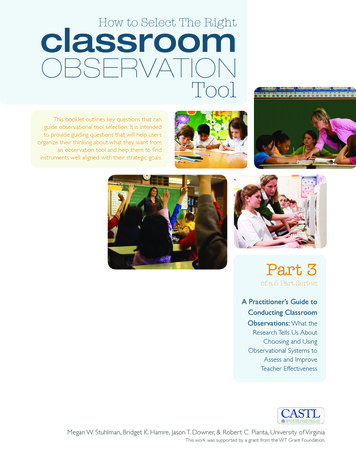
Transcription
How to Select The RightclassroomObservationToolThis booklet outlines key questions that canguide observational tool selection. It is intendedto provide guiding questions that will help usersorganize their thinking about what they want froman observation tool and help them to findinstruments well aligned with their strategic goals.Part 3of a 5 Part Series:A Practitioner’s Guide toConducting ClassroomObservations: What theResearch Tells Us AboutChoosing and UsingObservational Systems toAssess and ImproveTeacher EffectivenessMegan W. Stuhlman, Bridget K. Hamre, Jason T. Downer, & Robert C. Pianta, University of VirginiaThis work was supported by a grant from the WT Grant Foundation.
Choosing theRight Observational Tool:Factors to ConsiderThere are multiple published and unpublished classroom observation systems available for use, and deciding among themis the first step in putting an observational system to work inyour organization. The primary advantage of using an existing observation tool is that it saves a great deal of time andresources that would need to be put into developing an instrument with even minimal levels of reliability and validity forpredicting outcomes of interest.When reviewing such tools, the following questions can beused to guide the decision-making processes regarding whichobservation system is best suited to the needs of a particularorganization.Tier 1: High Priority Questions H as this tool been shown to produce reliable scoresacross observers and over time? A re the outputs (scores) from this observationprotocol proven to relate to outcomes of interest inour population (i.e., growth in students’ academic skills,students’ prosocial behaviors, teacher retention, students’reports of feelings of belonging, etc.)? In other words, isthe instrument valid for our intended purpose? W hat questions about classrooms does my organizationwant answered? Is the scope of this tool aligned with thequestions about classrooms and teachers’ practices thatwe want to address? A re the observation and scoring protocols standardizedand clear?Tier 2: Additional Considerations D oes the system include complementary sources ofinformation (such as student surveys, etc.) that couldbe used to obtain a more complete portrait of theclassroom? D oes the observation include guidelines and support forusing findings for professional development purposes? I s the time required for observation feasible for yourorganization?Does the observation includereliability information?Instrument reliability is a key consideration in selecting an observational assessment tool. Instrument reliability means thatwhatever qualities a given tool is measuring, it should measurethose qualities consistently. In observational assessments ofclassrooms, a tool that produces reliable scores will outputthe same score regardless of variation in the classroom thatis outside of the scope of the tool and regardless of who ismaking the ratings.For example, just as a yardstick registers the same number ofinches when measuring a given sheet of paper, regardless ofwhether that paper is measured during the day or at night,inside or outside, or who is holding the yardstick, a tool thatmeasures teachers’ ability to promote student language shouldproduce the same scores for the same behaviors, regardless ofwhether these behaviors occur during math or literacy, wholegroup or small group, and regardless of who is making theratings.No observation of teaching practices will produce perfectlyreliable scores. We know that despite high levels of training,observers will sometimes make different judgments. We alsoknow that certain classroom activities may influence scoreson observational tools. The goal is to choose an observationaltool that can produce relatively high-reliability scores and tobe aware of potential biases.There are several aspects of reliability. Perhaps the two mostrelevant when considering classroom observation systems arestability over time and consistency across observers. Withregard to stability over time, assuming a goal is to detect consistent and stable patterns of teachers’ behaviors, users needto know that constructs being assessed represent a stablecharacteristic of the teacher across situations in the classroomand are not random occurrences or behaviors that are linkedexclusively to the particular moment of observation. If ratingsshift dramatically and randomly from one observation cycle orday or week to the next, these ratings are not likely to represent core aspects of teachers’ practice.Key Concept –ReliabilityLook for instruments that provide scores that are: Consistent over time unless change is expected. Consistent across observers.Each of these questions is reviewed in more detail below.Conversely, if scores are at least moderately consistent acrosstime, they likely represent something stable about the set of2 : How to Select the Right Classroom Observation Tool
skills that teachers bring into the classroom setting, and feedback and support around these behaviors is much more likelyto resonate with teachers and to function as useful levers forhelping them change their practice. It is advantageous for observational tools to provide information on their test-retestreliability or the extent to which ratings on the tool are consistent across different periods of time (within a day, across days,across weeks, etc).A notable exception around the criteria of stability over timeas a marker for reliability is when teachers are engaged inprofessional development activities or are otherwise makingintentional efforts to shift their practice. In these cases, aswell as in cases where an organization’s curriculum is changingor new program-wide goals are being implemented, a lack ofstability in observations of teacher behaviors may well represent true change in core characteristics and not just random(undesired) fluctuation over time. In these cases, it would bedesirable to collect data on the extent of change and specificareas where change is observed.With regard to stability across observers, in order for resultsof observations to be useful at scale, training protocols andprovision of scoring directions must be clear and extensiveenough to produce an acceptable level of agreement acrossobservers. If there is very low agreement between two ormore observers’ ratings of the same observation period, thedegree to which the ratings represent the teachers’ behaviorrather than the observers’ subjective interpretations of thatbehavior or personal preferences is unknown.Conversely, if two independent observers can consistentlyassign the same ratings to the same patterns of observedbehaviors, this speaks to the fact that ratings truly representattributes of the teacher as defined by the scoring system, asopposed to attributes of the observer. Therefore, users maywish to select systems for which there is documented consensus among trained raters on whether or not or to what extentteachers are engaging in the behaviors under consideration.Does the tool provideinformation on validity?Validity represents the degree to which the ratings producedby the observation system are associated with the student orteacher outcomes about which the observation is designedto provide information. Along with reliability considerations,validity is one of the most important aspects to considerwhen selecting an observation instrument. Differentobservation systems have varying levels of data availableto show how closely aligned the outputs of observationsare with students’ performance in a specified area, students’growth on specified skill sets, or other outcomes of interest.Key Concept –ValidityLook for instruments that provide scores with provenlinks to outcomes of interest.Selecting instruments with demonstrated validity is criticalto making good use of observational methodology becausethis information allows users to have confidence that theinformation they are gathering is relevant to the outcomesthey are interested in, and that the types of behaviorsoutlined in the system can be held up as goals for highquality teacher practice.Without validity information, users have no such assurances.We must know that our assessment tools are directly andmeaningfully related to our outcomes of interest beforewe begin using them either in professional development oraccountability frameworks.A system may well be valid for one set of outcomes butnot for another, so clarity around outcomes of interest isimportant. For example, an observation system may includevalidity data regarding the prediction of students’ academicachievement during that school year, but it may demonstrateno relation to student drop-out rates in subsequent years. Ifthe objective of conducting the observation is to evaluatewhether teachers are engaging in behaviors that promotestudents’ learning over the course of the year, this instrumentmay be well-suited for that purpose. However, if theobjective is to determine whether teachers are enactingbehaviors that will prevent drop-out, a different observationwith documented links to drop-out rates may be preferable.If a user has a particular observation tool that is well alignedwith the questions they want answered about classroompractice and meets the criteria summarized previously, there isalways the possibility that no data will be available on validityfor the particular outcomes that the user is interested inevaluating. In these instances, it would certainly be possible touse the observation in a preliminary way and evaluate whetherit is, in fact, associated with outcomes of interest. For example,a district or organization could conduct a pilot test with asubgroup of teachers and students to determine whetherscores assigned using the observation tool are associated withthe outcomes of interest. This testing would provide somebasis for using the instrument for accountability or evaluativepurposes.In sum, the importance of selecting an observation systemthat includes validity information cannot be overstated. Itmay be more difficult to find instruments that have beenHow to Select the Right Classroom Observation Tool : 3
validated for your purposes, but this is truly essential for makingobservational methodology a useful part of teacher evaluationand support programs. If the teacher behaviors that areevaluated in an observation are known to be linked with desiredstudent outcomes, teachers will be more willing to reflect onthese behaviors and buy in to observationally-based feedback,teacher educators and school personnel can feel confidentestablishing observationally-based standards and mechanismsfor meeting those standards, and educational systems, teachers,and students will all benefit.What questions aboutclassrooms do I wantanswered? Do the scopeand design of the instrumentlend themselves to addressingthese questions?Scope of Observations. Different instruments provide users with different types of information about classrooms. Someare inclusive of multiple varied aspects of teaching practice, providing data on layers of setting quality including the physicalenvironment, the types of activities observed in the classroom,and the teacher’s execution of professional responsibilities suchas record keeping and communicating with families.Others adopt a highly focused approach, such as exclusivelyattending to a highly detailed and specific set of instructional interactions that take place within short observation windows orfocusing on comparisons between the experiences of specificgroups of students within the classroom.Still others strike a balance in terms of scope, including information on a variety of teacher and student behaviors but notincluding information that would require knowledge outside ofwhat is obtained during specified observation windows (i.e., notincluding how the teacher communicates with parents, makeslesson plans, etc.).Users may wish to begin the selection process by defining thegoals that their organization has in using an observation tool.After having defined the desired outcome, users can select ameasurement tool that is well aligned with their objectives.Age Range Covered. In addition to ensuring a matchbetween the scope of what is assessed by the instrument andsystem goals, users are also advised to attend to the age rangethat the instrument was designed for and the grade levels fromwhich data on the psychometric properties of the instrumenthave been obtained. For example, if your goal is to assess4 : How to Select the Right Classroom Observation Toolfourth-grade classrooms, it is ideal to use an instrument thatwas generated with this developmental level in mind and hasbeen validated for use with this age group.Global Versus Content Specific. Relatedly, some usersmay want to focus more on the provision of general supportfor learning, whereas others may have programmatic goals thatfocus more specifically on quality of instruction in differentcontent areas such as mathematics or reading. There areinstruments available that assess implementation of contentspecific learning supports, as well as tools that focus on supportslinked to student growth and development across content areas.If your organization has a particular interest in a certain contentarea, you may wish to supplement a protocol for observinggeneralized supports with one that includes specific interactivepractices relevant to your content area of focus.CASE STUDY # 1:Choosing an Observation Tool for aSpecific CurriculaThe Fairmont school district is considering mandating theuse of a new mathematics curriculum in all of its schools.A small number of teachers who are pilot testing the newcurriculum have been trained on this approach to teaching mathematics and have been provided with all neededmaterials. The district now wants to evaluate the extentto which teachers using this curriculum are incorporatinghigh-quality strategies for teaching mathematics in comparison with the extent to which teachers in a control groupof schools are incorporating such strategies in teachingmathematics in order to help them decide whether thiscurriculum may be a good choice for district-wide use.This school district may wish to use an observation protocol focused on research-based definitions and descriptionsof high-quality mathematics instruction or to supplement amore generalized observational protocol with a contentspecific protocol for mathematics instruction.CASE STUDY # 2:Choosing an GeneralizedObservational ToolThe Lakeview school district wishes to conduct an observational assessment of all teachers in order to gain abetter understanding of system-wide areas of strength andchallenge so that they can plan for in-service programmingand create individualized professional development plansfor teachers. Observers will conduct multiple observationsper day, so these observations will occur at different timesof day and during different activities for different teachers.
This district would likely benefit from use of a protocoldesigned to assess generalized supports for learning thatproduce benefits for student development across contentareas, as not all teachers will be observed teaching thesame content areas.CASE STUDY # 3:Choosing an Observational Tool forMerit Pay and TenureFranklin County school district wants to outline a structurefor merit pay and tenure decisions that includes quality ofobserved teaching behaviors as one of their components.Therefore, the county decides to select an assessmentinstrument that has shown a relationship to student outcomes at different levels of quality. In other words, onewith research support demonstrating that incrementalgains in the quality of the measured teaching practices result in incremental gains in student performance.They then stipulate two options for sufficient practice in thiscomponent: 1) teachers demonstrate high-quality teachingpractices in initial and follow-up assessments, or 2) teachersdemonstrate improvement over time in quality of teachingpractices/positive response to professional developmentsupport as indicated by increasing scores over time.Global Rating Methodology Versus FrequencyCounts of Behaviors. An additional consideration thatfalls in this scope category concerns the degree to whichobservational systems capture information on the frequenciesof certain teacher behaviors or on more holistically definedpatterns of behavior. Measures using time-sampling methodologyask users to count the number of specific types of behaviorsobserved. Global rating methodology guides users to watch forpatterns of behavior and make summative judgments aboutthe presence or absence of these behaviors.Examples of behaviors assessed by time-sampling measuresinclude: time spent on literacy instruction, the number of timesteachers ask questions during instructional conversations, andthe number of negative comments made by peers to oneanother. In contrast, global rating systems may assess thedegree to which literacy instruction in a classroom matches adescription of evidence-based practices, the extent to whichinstructional conversations stimulate children’s higher-orderthinking skills, and the extent to which classroom interactionscontain a high degree of negativity, both between teachers andstudents and among peers.There are advantages and disadvantages to each type ofsystem. An advantage to global ratings is that they assesshigher-order organizations of behaviors in ways that may bemore meaningful than looking at the discrete behaviors inisolation. For example, teachers’ positive emotions and smilingcan have different meanings and may be interpreted differentlydepending on the ways in which students in the classroomrespond. In some classrooms teachers are exceptionallycheerful, but their emotions appear very disconnected fromthose of the students. In other classrooms teachers are moresubdued in their expressed positive emotions but there is aclear match between this level of emotional expression andthat of the students.Key Concept –Observational MethodsTime-Sampling Methodology/Frequency Counts:most adept at highlighting differences within a specificteacher’s practices during different specific teachingactivities.Global Rating Methodology: most adept athighlighting stable teacher characteristics and at providinginformation that differentiates between teachers.A measure that simply counted the number of times ateacher smiled at students would miss these more nuancedinterpretations. However, an instrument characterized bytime-sampling methods, with a focus on frequencies ofspecific behaviors, may lend itself well to easy alignment withthe evaluation of certain interventions. For example, if a goalis to increase the numbers of times that teachers providestudents with specific and focused feedback rather than givingno feedback or simply saying “yes” or “no,” an instrument usingtime-sampling methods could provide very concrete data onthe extent to which an intervention impacted this specificbehavior by counting the frequencies of specific and focusedfeedback before and after the intervention (or in classroomsthat did and did not receive the intervention).Similarly, the success of an intervention designed to increasethe amount of time spent in learning activities (versus “downtime”) could be specifically evaluated using time-samplingmethods as well.One other difference between these two approaches concernsthe degree to which they are subject to observer effects.Theretend to be more significant observer effects using global ratingsthan time-samplings of more discrete behaviors. This finding isnot surprising given that global ratings tend to require greaterlevels of inference than do frequency approaches. Counting thenumber of times a teacher smiles requires much less inferenceHow to Select the Right Classroom Observation Tool : 5
than does making a holistic judgment about the degree towhich a teacher fosters a positive classroom climate.This pointemphasizes the need for adequate training and strategiesfor maintaining reliability among classroom observers, issuesconsidered in greater detail in the next sections.that their scoring is consistent? Are there guidelines aroundtraining to be completed before using the tool (i.e., do all observers need to pass a reliability test, observe in a certainnumber of classrooms, be consistent with colleagues at a certain level)?Another factor to consider is how much of the variance inthese ratings can be attributed to stable characteristics of theclassroom versus factors that change over time as a result ofsubject matter, number of students, time of day, etc. Evidencesuggests that time-sampled codes show little classroom-levelvariance, in contrast to global ratings, in which the bulk ofthe variance was at the classroom level. This indicates thatthe time-sampled codes are not as sensitive to differencesbetween teachers and classrooms as are the global ratings.This is an important consideration for users interested inobtaining information about different teachers’ individualizedstrengths and areas of challenge.Observation Protocol. Users are also advised to lookfor direction and standardization in terms of the length ofobservations, the start and stop times of observations (arethere predetermined times, times connected with start andend times of lessons/activities, or some other mechanism fordetermining when to begin and end?), direction around timeof day or specific activities to observe, as well as whether observations are announced or unannounced, and other relatedissues.Is the instrumentstandardized in terms ofadministration procedures?Does it offer clear directionsfor conducting observationsand assigning scores?Once you have clarified your purpose and goals in conductingclassroom observations, it is important to select an observation system that provides clear instructions for use, both interms of how to set up and conduct observations and how toassign scores. This is an essential component of a useful observation system: without standardized directions to follow, different people are likely to use different methods, which severelylimits the potential for agreement between observers whenmaking ratings, and thus hampers system-wide applicability.There are three main components of standardization that users may consider evaluating in an observation instrument:1. training protocol;2. observation protocol;3. scoring directionsTraining Protocol. With regard to the training protocol, are there specific directions for learning to use the instrument? Is there a comprehensive training manual oruser’s guide? Are there videos or transcripts with gold standard scores available that allow for scoring practice? Arethere other procedures in place that allow for reliabilitychecks such as having all or a portion of observers rate thesame classroom (live, via video, or via transcript) to ensure6 : How to Select the Right Classroom Observation ToolScoring Directions. With regard to scoring, users areadvised to look for clear guidelines. Do users score duringthe observation itself or after the observation. Is there a predefined observe/score interval? How are scores assigned? Isthere a rubric that guides users in matching what they observewith specific scores or categories of scores (i.e., high, moderate, low)? Are there examples of the kinds of practices thatwould correspond to different scores? Are scores assignedbased on behavior counts or qualitative judgments? How aresummative scores created and reported back to teachers?CASE STUDY # 4:Importance of ObservationalProtocolsA teacher preparation program is looking for a way to assess students’ performances at the beginning and end oftheir student teaching work, during which time they are alsotaking a course on effective teaching practice. They find“Observational Protocol A,” which has six clearly defined,theoretically based, 10-point scales that observers use torate teacher practice. Several members of the faculty readthe definition of the six scales and agree that the teachingbehaviors the scale assesses are aligned with the courseobjectives, as well as the broader goals of the program, andtherefore would be good targets for assessment. However,the system does not include training or observational protocols or explicit directions for scoring. As a consequence,it is used quite differently by two faculty members.When Professor Jones makes observations, he has arranged the observation time in advance with the teachers.He arrives at the appointed time, but does not begin theobservation until he can tell that the teacher is ready tobegin the lesson. He ends the observation as the teacherends the lesson. He takes detailed notes about the teachers’ practice along the six dimensions. When scoring, hereasons that if he sees teachers engaging in the behaviorsunder consideration several times, they should get “full
credit,” or a 10, on the scale. Professor Allen also conductsobservations using the same well defined scales, but hervisits are unannounced. She typically arrives at the beginning of the school day and begins taking notes as soon asshe arrives, and observes for two consecutive hours, regardless of start and stop time of activities. In terms ofscoring, she reasons that teachers start at a “1” level andshe moves the score up a point on the scale every time theteacher successfully engages in the behavior under consideration. Given these differences in protocol, it is likely thatProfessor Jones’ scores could be systematically higher thanProfessor Allen’s.We can see from this example that even with well defined and theoretically sound scales, a clear observationand scoring protocol that all observers follow is extremelyimportant in terms of obtaining scores that are consistentacross observers. In this example, note that significantlydifferent scores are likely to result from Professor Jones’observations and Professor Allen’s observations as a resultof their different administration and scoring techniques, andthat these scores may or may not reflect real differencesbetween the two teachers they observed. For example,if Professor Jones used his interpretation of the protocolto conduct initial start-of-student-teaching observationsand Professor Allen used her interpretation of protocolto conduct the end-of-student-teaching observations, anytrue gains in teaching practice could be obscured, and thepreparation program might conclude that the course andteaching experience did not function as effective preparation when in fact, if the teachers were evaluated usingthe same protocol on both measurement occasions, theymight have shown improvements.The four preceding factors represent key areas to considerwhen selecting an observation tool. Above and beyond thesecore factors, other potential considerations include:Does the system includecomplementary sourcesof information?Obtaining information about classrooms from multiple sources and from different perspectives (e.g., the teachers’ ownperspective, students’ perspectives, perspective of someonegenerally familiar with the classroom on a routine basis) canprovide a more comprehensive picture of the classroom environment. This can also be helpful in terms of providing constructive feedback – one could seek out coherent patterns inresponses across observers/raters.For example, having a teacher engage in a self-study or selfassessment in conjunction with structured observations madeby neutral observers may be a useful way of facilitating goalsetting and problem solving with teachers. Likewise, obtainingstudents’ perspectives can be an invaluable resource in un-Key Concept –Standardization ProceduresObservations should be standardized around: Training protocol Observation protocol Scoring directions.derstanding how specific teacher behaviors impact students’subjective experiences of the classroom.Does the observation includeguidelines and support forusing findings for professionaldevelopment purposes?As the goals of conducting observations include not onlygathering information on the quality of classroom processesbut also using that information to help teachers improve theirpractices (and, eventually, student outcomes), choosing observation systems that include a protocol to assist in translatingobservation data into professional development planning isdesirable. Information such as national norms and thresholdscores defining “good enough” levels of practice (levels ofquality that result in student improvement), or expected improvements in response to intervention would be extremelyuseful to have, although few, if any, instruments currently provide this kind of information to users.Also useful are guidelines or frameworks for reviewing resultswith teachers, suggested timelines for professional development work, protocols that can be given to teachers, placed infiles, and be easily translated into system-wide databases andhandouts with suggested competence-building techniques.Few observation systems provide these types of resourcesat this time.Is the time demand forconducting the observationworkable within my system?Different school systems have different resources available todevote to classroom observation. Some schools have personnel available to spend full days in classrooms in order to obtaindata on important aspects of classroom functioning. Otherschool systems have less time available on a per classroombasis. In selecting an observational assessment instrument, it isvitally important that the instrument is used in practice in thesame standardized ways it was used in development in orderto obtain results with the expected levels of reliability and validity. Some instruments have been tested and validated usingHow to Select the Right Classroom Observation Tool : 7
longer periods of observation than others. Users may wish togenerate a realistic approximation of how they will be able toallocate observation time before selecting an assess
teachers are engaging in the behaviors under consideration. Does the tool provide information on validity? Validity represents the degree to which the ratings produced by the observation system are associated with the student or teacher outcomes about which the observation is designed to provide information. Along with reliability considerations,
